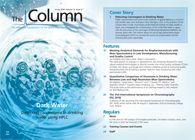Meeting Analytical Demands for Biopharmaceuticals with Mass Spectrometry in Late Development, Manufacturing, and Quality Control
Mass spectrometry (MS) is emerging as a critical tool in biopharmaceutical late stage development, manufacturing, and quality control (QC) environments. The rapid growth of biologics in development, the increasing demand for more robust analytical technologies to directly monitor the critical quality attributes (CQAs) of these new drugs, and longer term industry initiatives aimed at improving quality and productivity, such as quality by design (QbD) regulatory submissions and continuous manufacturing, are all fueling a greater need for mass monitoring with MS.
Photo Credit: Wragg/Getty Images

Joe FredetteandDiane Diehl, Waters Corporation, Milford, Massachusetts, USA.
Mass spectrometry (MS) is emerging as a critical tool in biopharmaceutical late stage development, manufacturing, and quality control (QC) environments. The rapid growth of biologics in development, the increasing demand for more robust analytical technologies to directly monitor the critical quality attributes (CQAs) of these new drugs, and longer term industry initiatives aimed at improving quality and productivity, such as quality by design (QbD) regulatory submissions and continuous manufacturing, are all fueling a greater need for mass monitoring with MS.
The growing number of novel biopharmaceutical products in clinical testing and in development represents a significant challenge for biologics producers and the laboratories tasked with analyzing these large, highly complex and variable compounds. According to recent estimates, biologics accounted for about 40% of prescription drug spending in the U.S.1 Compared to the period 2004–2008, when the U.S. Food and Drug Administration’s (FDA) Center for Drug Evaluation and Research (CDER) licensed an average of about three new biologics each year, that number doubled to six per year on average for 2009–2013, and jumped to 11 and 12 in 2014 and 2015, respectively.2 Seventy-five percent of the biologics approved in 2015 were first-in-class, and biologics represented 26.5% of new drug approvals last year, up from 14% in 2004.3
Biologics such as proteins, oligonucleotides, and peptide-based drugs are driving demand for robust and reliable analytical technologies with improved sensitivity and selectivity that facilitate accurate and detailed characterization of these new drugs and the processes used to produce them. Mass spectrometry (MS) is an ideal tool for performing these types of complex analyses. Not long ago, MS would have been considered too costly and complicated for use in late development production and quality control (QC) environments. In recent years, however, the availability of compact, robust, user-friendly and cost-effective MS instruments that can be added to existing chromatographic workflows using compliant-ready control software is making it possible for these regulated laboratories to benefit from the unique advantages of MS technology.
The increasing number of biologics on the market and in clinical testing, and the intensifying competition to commercialize biosimilars are driving efforts to accelerate product development and improve productivity. Developers of biopharmaceuticals face many challenges, key among these being the need to ensure product quality while improving productivity, accelerating time to market, and meeting the rapidly evolving and increasingly stringent requirements of global regulatory authorities. Biologics, by their very nature, are large and complex molecules that have an inherent degree of variability stemming from their three-dimensional structures and the range of potential post-translational modifications that can occur naturally. Production-related processes or storage conditions can also drive the variability. Consequently, biologics demand a greater level of characterization and analysis during development, such that a detailed molecular profile of the product is created and key critical quality attributes (CQAs) are defined. Monitoring of this profile is then essential, throughout production and QC and during stability testing, to ensure product purity, safety, and efficacy.
Biosimilars
In an article reviewing the stateâofâthe-art in analytical technologies for comparing biosimilars with their corresponding reference products, Berkowitz and coauthors stated that mass spectrometry is “a valuable tool for detecting and investigating protein modifications (by monitoring mass differences), for determining where they occur on the protein (by analyzing peptide fragments and their mass alterations) and for elucidating what causes them (by comparing different types of samples, storage conditions, and formulations).”4 The authors identified several trends that were driving a better understanding of batch-to-batch variability and more informative comparisons of “innovator” and biosimilar proteins: determining where glycosylation occurs; characterizing the nature of the individual sugars, their structure, and content; and measuring and differentiating glycosylation patterns to determine their clinical relevance. They pointed out, for example, that liquid chromatography coupled with mass spectrometry (LC–MS) has been used to detect differences between the successful Genentech/Roche monoclonal antibodyâbased drug trastuzumab (Herceptin) and a biosimilar.
Regulatory Drivers
As the FDA and global regulatory bodies have become more experienced with biologics, the level of product characterization recommended, and even required - including confirmation of a protein’s amino acid sequence, glycan profile, and post-translational modifications (PTMs) - has been increasing. With greater education and accumulated knowledge about these molecules and the impact and importance of specific CQAs on product quality, safety, and efficacy, the trend towards more stringent regulations is likely to continue. Regulated laboratories performing these analyses will need to adopt more sophisticated technologies, including LCâbased separation methods and MSâbased mass detection.
Further fueling the growing role that mass monitoring is playing downstream in late-stage development, manufacturing, and QC is the adoption of industry-wide initiatives aimed at maximizing productivity, minimizing risk, and improving process and product quality. Two initiatives in particular, quality by design (QbD) and continuous manufacturing (CM), require a much higher degree of process understanding, such that all the inputs and process control settings that can potentially have an impact on CQAs are clearly understood. Achieving this level of understanding requires extensive monitoring of both product and process attributes. The enhanced selectivity and sensitivity achieved with mass monitoring and the rapid analysis and multiplexing capabilities that MS provides are driving the integration of MS technology into QbD and CM workflows.
Quality by Design (QbD)
Regulatory authorities are encouraging pharmaceutical and biopharmaceutical companies to embrace QbD and to submit QbD applications for their manufacturing processes, because they know from other industries that adopting a QbD approach will improve quality and reduce the number of product recalls. In addition, manufacturers also like QbD because it gives them more flexibility to make changes and improvements to the manufacturing process over time without having to go through a GMP revalidation effort. Historically, pharmaceutical companies have been highly averse to making any changes to validated GMP processes because of the high cost, downtime, and risk associated with a revalidation effort. For a product that has been on the market for many years, this implies continuing to rely on old and often outdated assays, detection methods, and analytical instruments. While a greater level of investment may be required upâfront to develop a QbD application, which could include mass monitoring to build the necessary process understanding, companies will reap the rewards downstream in more ways than one.
Continuous Manufacturing (CM)
Biopharma companies are also increasingly looking to move from conventional batch production to CM. One of the main benefits is that producers can potentially reduce their manufacturing footprint by as much as 10–100-fold. In batch production, cells that produce a protein of interest are grown in large stainless steel bioreactors with volumes of thousands or tens of thousands of litres. When the batch is completed, the protein is purified and QC testing is performed. In contrast, CM uses a much smaller reactor in which cells are grown over a period of several weeks to months. The desired protein is continuously pulled out of the process stream, purified, and subject to QC analysis. Real-time process monitoring and feedback control are essential to ensure that optimal process parameters are maintained and product CQAs remain consistent. Whereas many sensor-based testing methods provide only an indirect measurement of the product and/or process, MS directly analyzes product and process attributes and provides a rapid and effective solution to support online monitoring in CM. The combination of direct product analysis and the high sensitivity and selectivity of MS can give laboratories greater confidence in their results.
Streamlining Workflows
The use of MS tools for monitoring product and process attributes in lateâstage development, manufacturing, and QC can also result in more streamlined analytical workflows by requiring fewer runs, and by reducing the amount of secondary MS analysis currently being outsourced to core MS labs or third party organizations. The ability to multiplex and perform multiple assays on a sample in a single LC–MS analysis is an idea that has gained attention in recent years, with Amgen’s multi-attribute-methodology (MAM) approach.5 Proponents of that strategy advocate for the use of a single LC–MS-based peptide mapping method to confirm the protein identification, N-linked glycan profiles, clipped species, as well as relative quantification of post-translational modifications (such as oxidation and deamidation), whereas the current, conventional approach requires separate testing for these attributes.
Into The Future
In a recent survey of biopharmaceutical scientists,6 nearly 70% of respondents indicated that they expected the utilization of MS in late development and QC to see a significant increase in the future. Also reflected in the survey, and not surprisingly, the biggest challenge to increasing this utilization is in overcoming the high cost and complexity of deploying and maintaining these tools in regulated laboratory environments, and ensuring robust performance as well as data integrity and compliance. Clear biopharmaceutical market trends, including an increase in QbD applications and accelerated adoption of continuous manufacturing, in addition to ongoing competitive pressure to speed development and increase productivity in product testing and release, are driving the increased utilization of MS tools further downstream in late development, manufacturing, and QC.
References
- L. Glover, Why are biologic drugs so costly? U.S. News & World Report 2015 Available at: http://health.usnews.com/health-news/health-wellness/articles/2015/02/06/why-are-biologic-drugs-so-costly (Last accessed May 2016).
- US Food and Drug Administration, NDA and BLA calendar year approvals. Available at: www.fda.gov (Last accessed May 2016).
- M. Serebrov, Biologics’ share of medicine chest grows, and so do the pricing concerns. Bioworld. Available at: www.bioworld.com/content/biologics-share-medicine-chest-grows-and-so-do-pricing-concerns. (Last accessed May 2016).
- S.A. Berkowitz, J.R. Engen, J.R. Mazzeo, and G.B. Jones, Nat. Rev. Drug Discov. 11(7), 527–540 (2012).
- R.S. Rogers et al., mAbs7(5), 881–90 (2015).
- Industry survey conducted by Waters Corporation May 2016.
Joe Fredette is Sr. Business Development Manager, Biopharmaceuticals, at Waters Corporation, Milford, Massachusetts, USA.
Diane Diehl is Director, Pharmaceutical Marketing, at Waters Corporation, Milford, Massachusetts, USA.
E-mail:joe_fredette@waters.com
Website:www.waters.com/biopharm

Biopharmaceutical Characterization in the Age of Artificial Intelligence
May 13th 2025AI-powered tools are enhancing precision, efficiency, and decision-making in biopharmaceutical development. Recently, Jared Auclair and Anurag Rathore explored AI's evolving role in biopharmaceuticals in detail.
Accelerating Monoclonal Antibody Quality Control: The Role of LC–MS in Upstream Bioprocessing
This study highlights the promising potential of LC–MS as a powerful tool for mAb quality control within the context of upstream processing.

.png&w=3840&q=75)

.png&w=3840&q=75)



.png&w=3840&q=75)



.png&w=3840&q=75)









